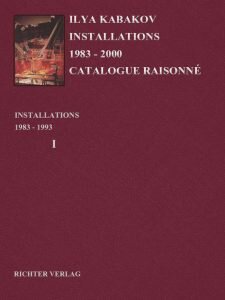The Red Wagon
YEAR: 1991
CATALOGUE NUMBER: 42
PROVENANCE
Version 1
The artist
2001, Collection Museum Wiesbaden
Version 2
Created in 2008 for exhibition at Moscow, Garage for the exhibition “Ilya and Emilia Kabakov, The Alternative History of Art.”
2009, Collection of The Hermitage Museum
EXHIBITIONS
Düsseldorf, Städtische Kunsthalle Düsseldorf
Sowjetische Kunst um 1990: Binationale, 12 Apr 1991 — 2 Jun 1991
Vienna, Österreichisches Museum für Angewandte Kunst
Tyrannei des Schönen – Architektur der Stalin-Zeit, 6 Apr 1994 — 17 Jul 1994
Wiesbaden, Museum Wiesbaden
Ilya Kabakov. Der Rote Waggon. The Red Wagon, 31 Oct 1999 — 31 Mar 2001
Garage, Moscow, Russia
“Ilya and Emilia Kabakov, The Alternative History of Art,” 2008
DESCRIPTION
The installation consists of three parts which constitute a unified whole with a length of 17 meters, a width of 3.5 meters, and a height of 7 meters. The first part, which comprises the beginning of the viewing and at the same time the entrance into the installation, consists of a wooden construction made in the ‘constructivist’ style of the 1920’s. It is an intricately built staircase leading upward and purportedly into space, into the sky. It represents movement toward a wonderful future. At the very top of the stairs are a lot of flags, pennants, slogans – festivity rules there in the sky.
Adjoining this structure from behind is a red train-car – long (9 meters) and wooden. The box, which looks like a train-car, is painted ‘train-car’ red-brown, and it stands on low wooden supports instead of on wheels. Sixteen paintings in the ‘Socialist Realist’ style are hung along both sides of the car in place of windows. Having stepped inside, the viewer winds up in a rather dark place. Stretching the entire length of the wagon on the left is a two-leveled bench inviting the viewer to sit down. The right side of the wagon appears to be a long stage where it seems that the action will begin any minute behind a wooden barrier. On the stage as a backdrop is a large painting depicting the plans for the ‘wonderful city of the future’: straight roads, buildings, green parks, dirigibles in the air. Rather loud music from the 1930’s and 1940’s resounds that is either lively or lyrical, full of energy. Behind the car is a small step but with broken railings. In general, beyond the car, terrible chaos and disorder reign, big piles of junk and garbage are heaped up: ripped up packaging, boards, boxes, empty crates; everything that is left over after the building and painting of the first two parts of the installation – the ‘stairs’ and the ‘train-car.’ It is everything, apparently, that should have been cleaned up and swept away, but either they didn’t have enough time, or they’ll take it away later, or else they simply forgot. It’s not clear, but this garbage comprises the third also important part of the installation.
ARTIST`S COMMENTS
I remember now how much anguish and horror were instilled in me by the grandiose pavilions of the agricultural exhibits and halls of the ‘Arena,’ a place of large, pompous built exhibits during the 1950’s-60’s. They were designed for visitation by enormous human masses, entire nations, at the extreme, even all of humanity. These exhibits were part of ‘Great Holidays’ – parades, grandiose demonstrations, rejoicing by the people – which were continually celebrated during that time as I remember it. The ‘Holidays’ were comprehensive happenings with no distinction indeed between the viewers and the performers, and all the triumphant people who had constructed Socialism were able to see who had built the ‘bright future,’ that is, they saw themselves, and they rejoiced, celebrated the occasion. In pre-revolutionary history, as we are told, holidays followed weekdays that were filled with gray, heavy labor, that’s exactly why they were ‘holidays’ – deriving from the Russian word for ‘idleness.’ The new world we had built had overcome this despondent rhythm, having abolished workdays and having called labor ‘the holiday of Socialist labor.’ Each day became a holiday on the occasion of constant victories which flowed uninterruptedly, one after another: victories over the old world, victories over Capitalism, over the enemy in the Patriotic War (WWII), over nature, over internal enemies. Just like holidays followed one after another, so did exhibitions replace one another: ‘The First of May,’ ‘The October Revolution,’ ‘Our Aviation,’ ‘Railroad Workers’ Day,’ ‘Our Militia.’
Each such pavilion at the Exhibition of Economic Achievements (VDNKh), where exhibits weren’t changed too often, seemed built to last for centuries and represented – similar to a medieval cathedral – the entire Soviet cosmos. Enormous murals on the ceiling depicted the expanding, shining sky, with silhouettes of construction cranes (symbols of building sites) and airplane squadrons disappearing in the zenith. The columns, either in the form of ripe ears of corn or in the form of trees, supported caisson ceilings, and enormous murals on the walls showed rejoicing people building houses and factories, running locomotives and advancing in joyful groups toward the ‘bright tomorrow.’ The exhibits inside the pavilions were elevated like remarkable, marvelous monuments reminding one of the grandiose sculptures of Arcimboldo: these were no longer just tractors, combines, machine benches, watermelons, melons, fabric, fur, but some sort of surrealistic constructions combining to form fountains, spirals, pyramids illuminated by lamps. Rather it seemed that everything wasn’t illuminated by lamps but that the thing itself emanated light … Next to these spaces bathed in sun and light, were darkened halls where the viewers could see objects and events which couldn’t fit in the pavilions: the landing of the ‘Papanitsevs’1 on the iceberg, the battle in Khalkin Gol, the erection of anti-aircraft defenses in Moscow during the war. All of this was presented in the form of enormous panoramas and dioramas which filled the entire dwelling, skillfully illuminated, wonderfully executed. Everything was as it was in reality, the coincidence was almost total thanks to the combination of painting, sculpture, light…
Images
Literature











